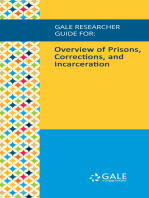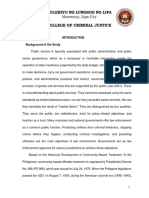Vera Housing Criminal Histories Fact Sheet
Vera Housing Criminal Histories Fact Sheet
Uploaded by
John TuringCopyright:
Available Formats
Vera Housing Criminal Histories Fact Sheet
Vera Housing Criminal Histories Fact Sheet
Uploaded by
John TuringOriginal Description:
Copyright
Available Formats
Share this document
Did you find this document useful?
Is this content inappropriate?
Copyright:
Available Formats
Vera Housing Criminal Histories Fact Sheet
Vera Housing Criminal Histories Fact Sheet
Uploaded by
John TuringCopyright:
Available Formats
Public Housing for People with
Criminal Histories
AUGUST 2015 FACT SHEET
Expanding Access to Public Housing for People with Criminal Histories
Housing stability is essential for breaking the cyclical relationship between incarceration and homelessness and
supporting a formerly incarcerated person’s successful return to his or her community (Metraux et al., 2008).
However, until recently, tenant-selection criteria in most public housing throughout the country have prevented
formerly incarcerated people from formally returning to their homes or living with family members in public
housing. Lacking other housing options, many of these people still lived with their families in public housing but
off the lease and “in the shadows,” which put their entire family at risk of eviction.
Promoting Family Reunification in Public Housing
To reduce the risk of recidivism, programs that prioritize family reunification and do not use a person’s criminal
history as a deterrent to housing access are crucial (Solomon et al., 2006). Research shows that improving access
to stable, affordable, quality housing substantially increases the likelihood that a person leaving prison or jail
will be able to connect with existing family support, find and retain employment, and rebuild supportive social
networks, reducing their reliance on homeless shelters and increasing public safety (La Vigne et al., 2009; Nelson
et al., 1999).
Since 2011, the U.S. Department of Housing and Urban Development (HUD) has explicitly encouraged all public
housing authorities (PHAs) to utilize their discretion in giving people a second chance at housing. A number
of housing authorities—in Baltimore, Chicago, Los Angeles, and New York City, for example—are running new
programs to help people with criminal histories access public housing. Others—such as in Oakland, CA and
Burlington, VT—have well-established programs, with successful track records.
> Chicago Housing Authority launched a pilot program for 30 people who have completed
a year of case management at one of three participating service providers. Providers issue
a certificate to participants, which they can use as proof of mitigation of circumstances, and
continue to work with them for an additional year. The pilot serves people with families in pub-
lic housing developments and in Section 8 housing, as well as people who wish to move into
their own subsidized unit. A similar pilot is underway with the Cook County Housing Authority.
> New York City Housing Authority (NYCHA) operates the Family Reentry Pilot Program—a
partnership between NYCHA, the New York City Department of Homeless Services, the
Corporation for Supportive Housing, and the Vera Institute of Justice (Vera). Through the
program, formerly incarcerated people join their families in public housing under temporary
permission and receive case management services from partnering nonprofits to facilitate
CENTER ON SENTENCING AND CORRECTIONS
successful reentry. Participants who complete the program can ultimately be added to the
household’s lease or can choose to use this as a temporary housing option while they get on
their feet.
> Oakland Housing Authority (OHA)’s Maximizing Opportunities for Mothers to Succeed
(MOMS) program, in operation now for 13 years, connects mothers in medium or minimum
security at the Santa Rita jail to housing provided by OHA. To be eligible, mothers must
participate in a counseling, education, and employment assistance program in the jail and
continue with case management services once they return to their community. The housing
authority has 11 units set aside for program participants. At the conclusion of the approxi-
mately 12-month program, women who successfully meet their programmatic goals and lease
requirements can apply for permanent housing and their prior conviction will not be held
against them. The program is planning to expand to 30 units and will include units for fathers
leaving jail.
Additional Policy Options to Reduce Homelessness and Improve Reentry
A growing number of PHAs across the country have begun to adopt policies that provide formerly incarcerated
people with the opportunity to live in federally subsidized housing. Below are two additional examples of how
jurisdictions can expand access to housing:
> Update screening criteria for new applicants and additions to the lease. Some PHAs have
reworked their screening processes to be more holistic in evaluating prospective applicants
with conviction histories. With support from Vera, the Housing Authority of New Orleans
amended its Admissions and Continued Occupancy Policy to establish more comprehensive
screening procedures that use a range of criteria for applicants with criminal records.
> “Ban the Box” for housing. Modeled after efforts to remove inquiries about criminal con-
victions on job applications, San Francisco and Newark, NJ have “fair chance” ordinances
for people applying for housing. In San Francisco, for example, affordable housing providers
must conduct individual assessments of each applicant with a conviction history, rather than
automatically denying his or her application. This assessment must consider directly related
convictions only, time since conviction, and evidence of rehabilitation.
For More Information
© 2015 Vera Institute of Justice. All rights reserved.
The Vera Institute of Justice is an independent nonprofit organization that combines research, demonstration proj-
ects, and technical assistance to help leaders in government and civil society improve the systems people rely on
for justice and safety. Vera’s Family Justice Program provides training, technical assistance, and research to help
community-based organizations and government agencies—such as corrections, parole and probation, and juvenile
justice entities—adapt their policies and practices to be strength-based and family-focused.
For more information, contact Margaret diZerega at mdizerega@vera.org.
You might also like
- Program Evaluation Proposal - Habitat For Humanity of JacksonvilleDocument12 pagesProgram Evaluation Proposal - Habitat For Humanity of JacksonvilleAlex SNo ratings yet
- KofutumanualwinterbelvisoDocument23 pagesKofutumanualwinterbelvisoVictoria Generao100% (3)
- Helping Moms, Dads & Kids Come Home: Eliminating Barriers To Housing For People With Criminal RecordsDocument31 pagesHelping Moms, Dads & Kids Come Home: Eliminating Barriers To Housing For People With Criminal RecordslegalactioncenterNo ratings yet
- Policy Alternative AssignmentDocument11 pagesPolicy Alternative Assignmentapi-246825887No ratings yet
- Member Discount List: Choose State: CaliforniaDocument26 pagesMember Discount List: Choose State: CaliforniaJohn TuringNo ratings yet
- Promoting Workforce Strategies For Reintegrating Ex OffendersDocument19 pagesPromoting Workforce Strategies For Reintegrating Ex Offendersaflee123No ratings yet
- 01 Services For Ex OffendersDocument32 pages01 Services For Ex OffendersBen WarnerNo ratings yet
- Prison overcrowding in CaliforniaDocument4 pagesPrison overcrowding in Californiawambuasolomon393No ratings yet
- Agency PaperDocument13 pagesAgency Paperapi-272668024No ratings yet
- Child Welfare BriefDocument2 pagesChild Welfare Briefaflee123No ratings yet
- Availability of Con Fidential Services For Teens Declined After The 2011e2013 Changes To Publicly Funded Family Planning Programs in TexasDocument6 pagesAvailability of Con Fidential Services For Teens Declined After The 2011e2013 Changes To Publicly Funded Family Planning Programs in TexasMario Rodríguez GonzálezNo ratings yet
- Addressing Homelessness.Document10 pagesAddressing Homelessness.josmaika40No ratings yet
- Family First Prevention Services Act Summary 061016Document3 pagesFamily First Prevention Services Act Summary 061016Beverly TranNo ratings yet
- Recidivism - ArticleDocument2 pagesRecidivism - Articlespring lookNo ratings yet
- Addressing HomelessnessDocument10 pagesAddressing Homelessnessjosmaika40No ratings yet
- Gale Researcher Guide for: Overview of Prisons, Corrections, and IncarcerationFrom EverandGale Researcher Guide for: Overview of Prisons, Corrections, and IncarcerationNo ratings yet
- Orange County, Where Are Orange County's Foster Children, 2007Document9 pagesOrange County, Where Are Orange County's Foster Children, 2007Rick ThomaNo ratings yet
- Quality Improvement Project - Final PaperDocument9 pagesQuality Improvement Project - Final Paperwinnie kizellahNo ratings yet
- Juvenile Delinquency Prevention: EducationDocument12 pagesJuvenile Delinquency Prevention: Educationghosh85No ratings yet
- Description: Tags: Section4Document10 pagesDescription: Tags: Section4anon-710035No ratings yet
- role o familyDocument26 pagesrole o familyfayrouz_ahmedNo ratings yet
- AdvocacyDocument3 pagesAdvocacyapi-336061781No ratings yet
- Ending Family Homelessness in MassachusettsDocument18 pagesEnding Family Homelessness in MassachusettsThe Boston GlobeNo ratings yet
- Holder J Community Assessment Homelessness San AngeloDocument11 pagesHolder J Community Assessment Homelessness San AngeloJames HolderNo ratings yet
- PCG Human Services Child Welfare Finance Reform White PaperDocument7 pagesPCG Human Services Child Welfare Finance Reform White PaperPublic Consulting GroupNo ratings yet
- Order 3614481-Policy Process Capstone Paper AssignmentDocument9 pagesOrder 3614481-Policy Process Capstone Paper AssignmentShaban KimuyuNo ratings yet
- Program Evaluation PaperDocument8 pagesProgram Evaluation PaperNaomiNo ratings yet
- Bremer Et AlDocument2 pagesBremer Et Alapi-201188516No ratings yet
- Agency Presentation-CsiDocument10 pagesAgency Presentation-Csiapi-243106884No ratings yet
- Margarito J, Garcia, III, Ph.D. - ED Review (071015) PDFDocument5 pagesMargarito J, Garcia, III, Ph.D. - ED Review (071015) PDFEditorNo ratings yet
- Aligning Housing and Education - 0Document25 pagesAligning Housing and Education - 0kirosNo ratings yet
- c2 PrintDocument11 pagesc2 Printhabu.panahon.auNo ratings yet
- Naturally Occurring Retirement Communities: A Model For Aging in PlaceDocument5 pagesNaturally Occurring Retirement Communities: A Model For Aging in PlaceScribd Government DocsNo ratings yet
- Homelessness Prevention and Rapid Re-Housing - NAEHDocument8 pagesHomelessness Prevention and Rapid Re-Housing - NAEHmarianenasalas6No ratings yet
- Chaffin Et Al 2001 Family Preservation Support ProgramsDocument21 pagesChaffin Et Al 2001 Family Preservation Support Programsarturbaran.akNo ratings yet
- 2013 Annual Gathering: Workshop #6C: Residentially-Based Services Collaboration and Innovation in Continuity of CareDocument34 pages2013 Annual Gathering: Workshop #6C: Residentially-Based Services Collaboration and Innovation in Continuity of CareCatholic Charities USANo ratings yet
- Juvenile Delinquency PreventionDocument4 pagesJuvenile Delinquency PreventionStéphane DoueuNo ratings yet
- Child Welfare Watch: Pressures and PossibilitiesDocument32 pagesChild Welfare Watch: Pressures and PossibilitiesCenterNYCNo ratings yet
- FINAL SF and NYC Probation Webinar Nov 21 SlidesDocument17 pagesFINAL SF and NYC Probation Webinar Nov 21 SlidesPhil WasobaNo ratings yet
- Sociology of HomelessnessDocument3 pagesSociology of HomelessnessDennis N. MurimiNo ratings yet
- Early InterventionDocument23 pagesEarly InterventionjinkyNo ratings yet
- Best-Keepfamily-2019Document26 pagesBest-Keepfamily-2019fayrouz_ahmedNo ratings yet
- Aftercare Definition of AftercareDocument4 pagesAftercare Definition of Aftercareprashamsa7ghimireNo ratings yet
- Service Delivery Monitoring ENGDocument15 pagesService Delivery Monitoring ENGedrisaedwardNo ratings yet
- Social Reintegration ProgramDocument13 pagesSocial Reintegration Programkomal kingerNo ratings yet
- Knowledge To Action Note Child Support Policy Around The WorldDocument2 pagesKnowledge To Action Note Child Support Policy Around The Worldloftyshop202No ratings yet
- For Bookbind (PARTIAL)Document73 pagesFor Bookbind (PARTIAL)Dave julius CericoNo ratings yet
- Does International Child Sponsorship WorkA Six-Country Study of Impacts On Adult LifeOutcomesDocument44 pagesDoes International Child Sponsorship WorkA Six-Country Study of Impacts On Adult LifeOutcomesTeddy RiantoNo ratings yet
- 2012 CI FP Summit ReportDocument24 pages2012 CI FP Summit ReportMuhammad FarhanNo ratings yet
- Crisostomo Jay Patrick CRIM 5Document4 pagesCrisostomo Jay Patrick CRIM 5baguiojay93No ratings yet
- Rehabilitation For Victims of Child Marriage Is Crucial To Help Them Recover From TraumaDocument3 pagesRehabilitation For Victims of Child Marriage Is Crucial To Help Them Recover From TraumaShreyanshi TripathiNo ratings yet
- Affordable Housing Needs AssessmentDocument227 pagesAffordable Housing Needs AssessmentPatrick Anderson100% (1)
- CA2 WEEK 1 5docDocument16 pagesCA2 WEEK 1 5docabdellhadaniNo ratings yet
- Protocol For A Systematic Review of Policies Programs or Interventions Designed To Improve Health andDocument9 pagesProtocol For A Systematic Review of Policies Programs or Interventions Designed To Improve Health andMARIAJOSE VEGA FLOREZNo ratings yet
- Challenges and Problems.......Document35 pagesChallenges and Problems.......Hermie Lagunay Pelayo75% (4)
- Sub 27 - National Women's Safety Alliance - ParentsNextDocument5 pagesSub 27 - National Women's Safety Alliance - ParentsNextjoseftihutaNo ratings yet
- Durfee Et Al-2006-Journal of Marriage and Family PDFDocument16 pagesDurfee Et Al-2006-Journal of Marriage and Family PDFjguzmancoxNo ratings yet
- Foster Care in CaliforniaDocument24 pagesFoster Care in California10881478No ratings yet
- Tips For Working With Jobseekers Newly Released From PrisonDocument4 pagesTips For Working With Jobseekers Newly Released From Prisontjprograms100% (1)
- S5 - L8 - Banerjee Et Al. (2018) Tangible Information and Citizen EmpowermentDocument41 pagesS5 - L8 - Banerjee Et Al. (2018) Tangible Information and Citizen EmpowermentDaniel DazaNo ratings yet
- Out and Free: Stories of Former Probationers’ Journey to Renewed LifeDocument17 pagesOut and Free: Stories of Former Probationers’ Journey to Renewed LifeAJHSSR JournalNo ratings yet
- Re-Entry Housing Issues Report FinalDocument36 pagesRe-Entry Housing Issues Report FinalJohn TuringNo ratings yet
- Unit 4 Sales Tax Fact SheetDocument2 pagesUnit 4 Sales Tax Fact SheetJohn TuringNo ratings yet
- 2020 Budget OverviewDocument17 pages2020 Budget OverviewJohn TuringNo ratings yet
- RCI Reentry Resource Guide 2018Document49 pagesRCI Reentry Resource Guide 2018John TuringNo ratings yet
- RPC YARP Program Participant HandbookDocument12 pagesRPC YARP Program Participant HandbookJohn TuringNo ratings yet
- Reentry Resource Flyer UPDATED 03052019Document2 pagesReentry Resource Flyer UPDATED 03052019John TuringNo ratings yet
- RPC Yarp BrochureDocument2 pagesRPC Yarp BrochureJohn TuringNo ratings yet
- CIT Responses in Champaign County Aug 2017 - 2018Document18 pagesCIT Responses in Champaign County Aug 2017 - 2018John TuringNo ratings yet
- Illinois Solar Farm Tour Slides 2018Document36 pagesIllinois Solar Farm Tour Slides 2018John TuringNo ratings yet
- CUI Fair Housing StatementDocument10 pagesCUI Fair Housing StatementJohn TuringNo ratings yet
- Solar Farm Project Fact Sheet - With FAQs - 100417Document2 pagesSolar Farm Project Fact Sheet - With FAQs - 100417John TuringNo ratings yet
- Nra 223 RemingtonDocument6 pagesNra 223 RemingtonJohn TuringNo ratings yet
- Path Resource GuideDocument2 pagesPath Resource GuideJohn TuringNo ratings yet
- Member Discount List: Choose State: IllinoisDocument9 pagesMember Discount List: Choose State: IllinoisJohn TuringNo ratings yet
- Member Discount List: Choose State: National ListingsDocument70 pagesMember Discount List: Choose State: National ListingsJohn TuringNo ratings yet
- Re-Entry Guide 2017 - Web PDFDocument242 pagesRe-Entry Guide 2017 - Web PDFJohn TuringNo ratings yet
- Biosphere Reserves of India (Area Wise)Document27 pagesBiosphere Reserves of India (Area Wise)Sarvesh SinghNo ratings yet
- The Blackwell Philosophy and Pop Culture Series Inception and Philosophy Because It S Never Just A Dream Part One Was Mal Right Was It All Just A Dream Making Sense of InceptionDocument60 pagesThe Blackwell Philosophy and Pop Culture Series Inception and Philosophy Because It S Never Just A Dream Part One Was Mal Right Was It All Just A Dream Making Sense of InceptionDouglas YoungNo ratings yet
- KEEPING QUIET MCQs and CBQsDocument7 pagesKEEPING QUIET MCQs and CBQsjaywardhanbaba100% (1)
- Benjamin Franklin PowerpointDocument14 pagesBenjamin Franklin Powerpointapi-247450357No ratings yet
- The Art of Attraction Full Report PDFDocument61 pagesThe Art of Attraction Full Report PDFjavaclinicNo ratings yet
- EPIC FTC Nest GoogleDocument1 pageEPIC FTC Nest GoogleBryan LoganNo ratings yet
- CFLM MidtermDocument3 pagesCFLM MidtermShe Lah Fene QuitoNo ratings yet
- Rau S Mains Compass 2022 Ethics Integr AptitDocument151 pagesRau S Mains Compass 2022 Ethics Integr Aptitshauryap2720No ratings yet
- CRM 19820 2011 06 11 2012 Interim OrderDocument4 pagesCRM 19820 2011 06 11 2012 Interim OrderRahul JainNo ratings yet
- Defence TijaniDocument14 pagesDefence TijaniIsma'eel BakareNo ratings yet
- Colgate Company Ebm 640 Group ProjectDocument16 pagesColgate Company Ebm 640 Group ProjectKubra Lawan BadawiNo ratings yet
- TXSCC's Notes On "The Growing Crisis of Guns On Campus"Document3 pagesTXSCC's Notes On "The Growing Crisis of Guns On Campus"Texas Students for Concealed CarryNo ratings yet
- Judgment Sheet. in The Lahore High Court Lahore Judicial DepartmentDocument15 pagesJudgment Sheet. in The Lahore High Court Lahore Judicial Departmentasad tariqNo ratings yet
- Using The MBTI To Enhance Workplace Communication PDFDocument4 pagesUsing The MBTI To Enhance Workplace Communication PDFVijay Chandra SekarNo ratings yet
- a.PRE-TRIAL BRIEF PLAINTIFFDocument7 pagesa.PRE-TRIAL BRIEF PLAINTIFFThirdy DemonteverdeNo ratings yet
- MPU3322 Individual Assignment - Freeze (Firzan) - ADRDocument6 pagesMPU3322 Individual Assignment - Freeze (Firzan) - ADRshazreenivaNo ratings yet
- Itl 528 PlanDocument6 pagesItl 528 Planapi-377713383No ratings yet
- Face Theory of Conflict NegotationDocument11 pagesFace Theory of Conflict NegotationJefmo JefmoNo ratings yet
- Community Survey.Document10 pagesCommunity Survey.RJNo ratings yet
- Architectural Legislation LEC !Document18 pagesArchitectural Legislation LEC !Pranika Mahajan100% (2)
- ANKITA DAWRA. Curriculum VitaeDocument4 pagesANKITA DAWRA. Curriculum VitaeAnkitaAroraNo ratings yet
- ID 1878 Trento Lawtech Research Paper 1Document299 pagesID 1878 Trento Lawtech Research Paper 1ManuelZometaNo ratings yet
- G.R. No. 190515 Cirtek Ee Labor Union V Cirtek ElectronicsDocument8 pagesG.R. No. 190515 Cirtek Ee Labor Union V Cirtek ElectronicsRogie ToriagaNo ratings yet
- Clean Air Act Irr ContDocument1 pageClean Air Act Irr ContkeithnavaltaNo ratings yet
- DPAS: Special Priorities AssistanceDocument16 pagesDPAS: Special Priorities AssistanceanuprashmiNo ratings yet
- TV Series in Turkish Foreign Policy Aspects of Hegemony and Resistance Author S Constantinos M Constantinou and Zenonas TziarrasDocument5 pagesTV Series in Turkish Foreign Policy Aspects of Hegemony and Resistance Author S Constantinos M Constantinou and Zenonas TziarrasC. ANo ratings yet
- Arthur AndersenDocument5 pagesArthur AndersenWill KaneNo ratings yet
- Teacher As A Role Model Effects On Students SocializationDocument4 pagesTeacher As A Role Model Effects On Students SocializationUmar DrazNo ratings yet
- SMM Part IV Rev 1Document194 pagesSMM Part IV Rev 1Iurii BelousNo ratings yet










































































































